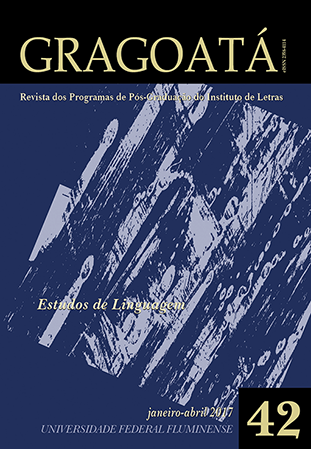Ethnicity in Motion: constructing Brasilidade by giving former migrants autochthonous status
DOI:
https://doi.org/10.22409/gragoata.v22i42.33461Palavras-chave:
Brasil. Uso linguístico. Autóctone. Política linguística. Bilinguismo.Resumo
The paper presents the postmodern perspective on autochthony from a theoretical approach. The previously held contrast between allochthonous and autochthonous people has undergone a change; nowadays, researchers propose that the two qualities form the poles of a continuum, where different grades of being autochthones may be distinguished. As has Canada, the Brazilian government has recently paved the way, conceding the status of autochthony to language communities living for at least three generations in the country. By recognizing cultural, and at the same time linguistic diversity as an important essential part of the process of constructing the new image of being Brazilian, a brasilidade (LESSER, 2015), the unique language use developed by descendents of European migrants, is now regarded as part of the historical and artistic immaterial patrimony in South America.
----------------------------------------------------------------------------------------------------------
Etnicidade em movimento: construindo brasilidade ao conceder o estatuto de autóctones aos primeiros imigrantes
O artigo apresenta a perspectiva pós-moderna na autoctonia a partir de uma abordagem teórica. O contraste antes estabelecido entre povos alóctones e povos autóctones sofreu uma mudança; na atualidade, os pesquisadores propõem que as duas qualidades formam os polos de um contínuo, no qual podem ser distinguidos diferentes níveis de existência autóctone. Como o Canadá, o governo brasileiro também abriu o caminho, concedendo o estatuto de autoctonia a comunidades linguísticas vivendo por até três gerações no país. Ao reconhecer a diversidade cultural e ao mesmo tempo linguística como um elemento essencial ao processo de construção de uma nova imagem do brasileiro, a brasilidade (LESSER, 2015), o uso linguístico especial desenvolvido pelos descendentes de imigrantes europeus é agora considerado parte do patrimônio artístico e histórico imaterial na América do Sul.
---
Artigo em inglês.
---
DOI: http://dx.doi.org/10.22409/gragoata.2017n42a915
Downloads
Downloads
Publicado
Edição
Seção
Licença
AUTORIZAÇÃO
Autores que publicam em Gragoatá concordam com os seguintes termos:
Os autores mantêm os direitos e cedem à revista o direito à primeira publicação, simultaneamente submetido a uma licença Creative Commons Atribuição 4.0 Internacional (CC BY 4.0), que permite o compartilhamento por terceiros com a devida menção ao autor e à primeira publicação pela Gragoatá.
Os autores podem entrar em acordos contratuais adicionais e separados para a distribuição não exclusiva da versão publicada da obra (por exemplo, postá-la em um repositório institucional ou publicá-la em um livro), com o reconhecimento de sua publicação inicial na Gragoatá.
A Gragoatá utiliza uma Licença Creative Commons - Atribuição CC BY 4.0 Internacional.











